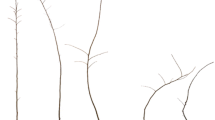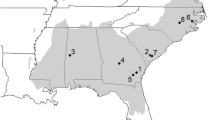Abstract
The first estimates of the importance of epistatic effects within Eucalyptus globulus were obtained from analysis of clonally replicated full-sib progeny tests grown in Portugal. Parents comprised diverse selections from the Portuguese landrace. Variance components were estimated for 4-year-old diameter growth and pilodyn penetration, an indirect measure of wood density, both key traits in the pulpwood breeding objective. The experimental components of variance were used to estimate heritabilities and proportions of the phenotypic variance due to dominance and epistasis. The additive variance was the only significant genetic component affecting either diameter or pilodyn. Estimates of the additive, dominance and epistatic effects accounted for 8–10%, 0–4% and 0.4% of the phenotypic variance in diameter, and for 11–17%, 0% and 5% of the phenotypic variance in pilodyn, respectively. A comparison of residual coefficients of variation within seedling and cloned progenies indicated that C effects within clones were not a serious source of random variability. Despite the test sites encompassing a diverse range of locations, no important genotype by environment interaction was detected. The results suggested that an improvement strategy combining both recurrent selection for additive genetic merit and clonal testing may be adequate for optimizing genetic gains from this genetic base.
Similar content being viewed by others
References
Borralho NMG (1994) Heterogeneous selfing rates and dominance effects in estimating heritabilities from open-pollinated progeny. Can J For Res 24:1079–1082
Borralho NMG, Almeida IM, Cotterill PP (1992) Genetic control of growth of young Eucalyptus globulus clones in Portugal. Silvae Genet 41:100–105
Burdon RD, Shelbourne CJA (1974) The use of vegetative propagules for obtaining genetic and physiological information. NZ J For Sci 4:418–425
Chang HL, Fernando RL, Gianola D (1990) An evaluation of maximum likelihood estimates of non-additive genetic variances. In: Hill WC, Thompson R, Wooliams JA (eds) Proceedings of the 4th World Congress on Genetics Applied to Livestock Production, Edinburgh. 13:437
Comstock RE, Kelleher T, Morrow EB (1958) Genetic variation in an asexual species, the garden strawberry. Genetics 43:634–646
Doughty RW (2000) The eucalyptus: a natural and commercial history of the gum tree. Johns Hopkins University Press, Baltimore
Falconer DS, Mackay TFC (1996) Introduction to quantitative genetics. Addison Wesley Longman, Edinburgh Gate, Harlow
Foster GS, Shaw DV (1988) Using clonal replicates to explore genetic variation in a perennial plant species. Theor Appl Genet 76:788–794
Foster GS, Campbell RK, Adams WT (1984) Heritability, gain, and C effects in rooting of western hemlock cuttings. Can J For Res 14:628–638
Gilmour AR, Thompson R, Cullis BR (1995) Average information REML, an efficient algorithm for variance parameter estimation in linear mixed models. Biometrics 51:1440–1450
Gilmour AR, Cullis BR, Welham SJ, Thompson R (1999) ASREML reference manual. Biomet Bull No. 3, NSW Agriculture, Orange, Australia
Griffin AR, Cotterill PP (1988) Genetic variation in growth of outcrossed, selfed and open-pollinated progenies of Eucalyptus regnans and some implications for breeding strategy. Silvae Genet 37:124–131
Griffing B (1956) Concept of general and specific combining ability in relation to diallel crossing systems. Aust J Biol Sci 9:463–493
Hardner C, Tibbits W (1998) Inbreeding depression for growth, wood and fecundity traits in Eucalyptus nitens. For Genet 5:11–20
Henderson CR (1984) Applications of linear models in animal breeding. University of Guelph, Ontario
Hodge GR, Volker PW, Potts BM, Owen JV (1996) A comparison of genetic information from open-pollinated and control-pollinated progeny tests in two eucalypt species. Theor Appl Genet 92:53–63
Libby WJ, Jund E (1962) Variance associated with cloning. Heredity 17:533–540
Lopez GA, Potts BM, Dutkowski GW, Apiolaza LA, Gelid PE (2002) Genetic variation and inter-trait correlations in Eucalyptus globulus base population trials in Argentina. For Genet 9:217–232
Lu PX, Huber DA, White TL (1999) Potential biases of incomplete linear models in heritability estimation and breeding value prediction. Can J For Res 29:724–736
Lynch M, Walsh B (1998) Genetics and analysis of quantitative traits. Sinauer, Sunderland, Mass.
MacDonald AC, Borralho NMG, Potts BM (1997) Genetic variation for growth and wood density in Eucalyptus globulus ssp. globulus in Tasmania (Australia). Silvae Genet 46:236–241
Mäki-Tanila A, Kennedy BW (1986) Mixed model methodology under genetic models with a small number of additive and non-additive loci. In: Proceedings of the 3rd World Congress on Genetics Applied to Livestock Production, Lincoln, Neb.12:443–448
Matheson AC, Lindgren D (1985) Gains from the clonal and the clonal seed-orchard options compared for tree breeding programs. Theor Appl Genet 71:242–249
Mullin TJ, Park YS (1992) Estimating genetic gains from alternative breeding strategies for clonal forestry. Can J For Res 22:14–23
Mullin, TJ, Park YS, Fowler, DP (1992) Genetic parameters from a clonally replicated test of black spruce (Picea mariana). Can J For Res 22:24–36
Muneri A, Raymond CA (2000) Genetic parameters and genotype-by-environment interaction for basic density, pilodyn penetration and stem diameter in Eucalyptus globulus. For Genet 7:317–328
Patterson HD, Thompson R (1971) Recovery of interblock information when blocks sizes are unequal. Biometrika 31:100–109
Paul AD, Foster GS, Caldwell T, McRae J (1997) Trends in genetic and environmental parameters for height, diameter and volume in a multilocation clonal study with loblolly pine. For Sci 43:87–98
Raymond CA, MacDonald AC (1998) Where to shoot your pilodyn: within tree variation in basic density in plantation Eucalyptus globulus and E. nitens in Tasmania. New For 15:205–221
Rosvall O, Lindgren D, Mullin TJ (1998) Sustainability robustness and efficiency of a multi-generation breeding strategy based on within-family clonal selection. Silvae Genet 47:307–321
Shaw DV, Hood JV (1985) Maximizing gain per effort by using clonal replicates in genetic tests. Theor Appl Genet 71:392–399
Shelbourne CJA (1991) Genetic gains from different kinds of breeding population and seed or plant production population. S Afr For J 160:49–65
Snedden CL, Verryn SD, Roux CZ (2000) Broad- and narrow sense heritabilities in a cloned open pollinated Eucalyptus grandis breeding population. In: Forest genetics for the next millennium. Proceedings IUFRO working party 2.08.01, Durban, South Africa, 8–13 October 2000, pp 214–220
Stonecypher RW, McCullough RB (1986) Estimates of additive and non-additive variances from a clonal diallel of Douglas-fir Pseudotsuga menziesii (Mirb.) Franco. In: Proceedings IUFRO joint meeting of working parties on breeding theory, progeny testing and seed orchards, Williamsburg, Va., 13–17 October 1986. North Carolina State University-Industry Cooperative Tree Improvement Program, Raleigh, pp 211–227
Van der Werf JHJ, de Boer W (1989) Influence of non additive effects on estimation of genetic parameters in dairy cattle. J Dairy Sci 72:2606–2614
Volker PW (2002) Genetics of Eucalyptus globulus, E. nitens and their F1 hybrid. PhD dissertation, University of Tasmania
Wu RL (1996) Detecting epistatic genetic variance with a clonally replicated design: models for low- vs high-order nonallelic interaction. Theor Appl Genet 93:102–109
Acknowledgements
We wish to express our gratitude to Dr. Maria Helena Almeida for valuable comments on an earlier version of the manuscript, to Eng. José Alexandre Araújo for helpful technical assistance with the field trials, and to Fundação para a Ciência e Tecnologia (Lisboa, Portugal) for financial support.
Author information
Authors and Affiliations
Corresponding author
Additional information
Communicated by O. Savolainen
Rights and permissions
About this article
Cite this article
Costa e Silva, J., Borralho, N.M.G. & Potts, B.M. Additive and non-additive genetic parameters from clonally replicated and seedling progenies of Eucalyptus globulus . Theor Appl Genet 108, 1113–1119 (2004). https://doi.org/10.1007/s00122-003-1524-5
Received:
Accepted:
Published:
Issue Date:
DOI: https://doi.org/10.1007/s00122-003-1524-5




